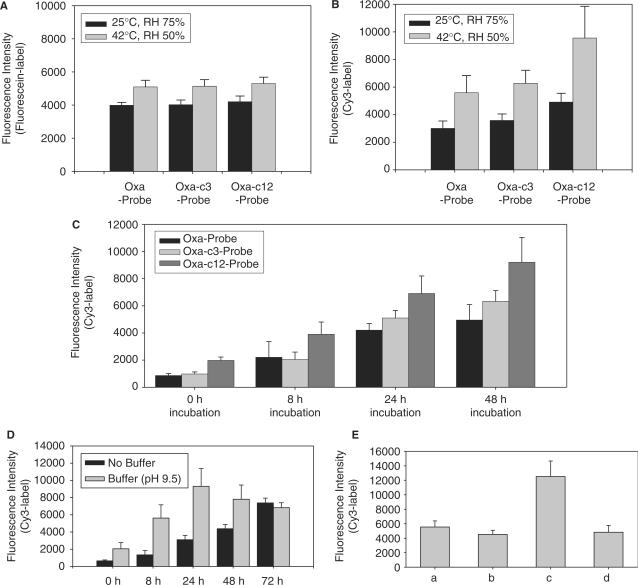Figure 4.
Effects of the experimental parameters, such as temperature, relative humidity, reaction time, pH and additional UV irradiation in the employment of post-spotting treatment, on the performance of the modifier as a linker on the NH2-functionalized glass slide. (A) Immobilization efficiency obtained for the probes with Oxa-N at the 5′-end by measuring fluorescein-label at the 3′-end (Oxa-Probe-F, Oxa-c3-Probe-F and Oxa-c12-Probe-F). The mild conditions of post-spotting treatment were employed on the spotted glass slide and then, the immobilization efficiency of each spot was analyzed for the evaluation of Oxa as a linker. Gray bars were obtained by one mild condition of post-spotting treatment (at 25°C and RH 75% for 48 h), and the black bars by another mild condition of post-spotting treatment (at 42°C and RH 50% for 24 h). [εmax (fluorescein) = 75 000 (M−1 cm−1)]. (B) Hybridization efficiency obtained for the probes with Oxa-N at the 5′-end (Oxa-Probe, Oxa-c3-Probe and Oxa-c12-Probe). The hybridization efficiency of each spot was analyzed for the evaluation of the performance of the modifier as a linker. The representation of gray and black bars in the figure and the mild conditions of post-spotting treatment are the same as explained in (A). [εmax (Cy3) = 136 000 (M−1 cm−1)]. (C) Time-dependent performance of Oxa as a linker under the mild conditions of post-spotting treatment (at 42°C and RH 50%). The resultant hybridization efficiency was analyzed for the evaluation. Probes with Oxa-N at the 5′-end (Oxa-Probe, Oxa-c3-Probe and Oxa-c12-Probe) were used and the target was Cy3-XDHt-L. The vertical axis shows the Cy3-fluorescence intensities of the spots including the duplexes between the probes and the target. (D) Effect of the spotting solution pH on the covalent bonding formation between Oxa and amino group on the surface. The resultant hybridization efficiency and its time-dependent change were analyzed for the evaluation of the performance of Oxa as a linker. The probe was Oxa-Probe and the target Cy3-XDHt-L. The black bars were the results obtained without the pH control, and the gray bars were the results obtained by adding the same amount of phosphate buffer solution to the spotting solution (final pH 9.5). (E) Effect of the combinations of the post-spotting treatments on the performance of Oxa as a linker. First, the mild conditions of the post-spotting treatment (72 h incubation at 42°C and RH 50%) were employed on the glass slide, in which Oxa-Probe in original spotting solution was spotted and then, the glass slide were subsequently subjected to other conventional post-spotting treatments such as (a) none, (b) baking (at 80°C for 2 h) and (c) UV irradiation at 600 mJ. Bar (d) was obtained without the employment of the mild treatment but only by UV irradiation at 600 mJ. All the spots were then hybridized with the target Cy3-XDHt-L and measured for Cy3-fluorescence intensities. The resultant hybridization efficiency was used for the evaluation of the performance of Oxa as a linker.

